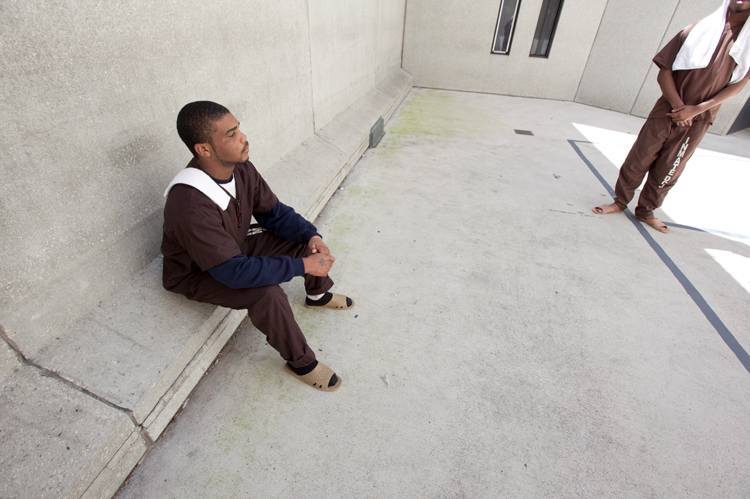A day before holding a lecture at Kennesaw State University in Georgia, Richard Ross visited his friend, Ronald F., in Miami.
“It was his birthday,” Ross said. “He’s 18 this past week, and they switched him over to an adult facility.”
 Ross said that prior to his incarceration, he was a special education student in the sixth grade. He said that for 30 years, his mother was a crack addict.
Ross said that prior to his incarceration, he was a special education student in the sixth grade. He said that for 30 years, his mother was a crack addict.
“Before he got brought in on these charges, four and a half years ago, she tried to kill him, quite literally stab him to death,” Ross stated.
Ross said that the young man wound up falling through the cracks of the child welfare system, and began running with “the wrong crowd.” At 13, Ross said he was accused of some “heinous” crimes, which ultimately resulted in his incarceration at a juvenile detention facility for 51 months.
As of his 18th birthday, Ross said, “Ronald hasn’t gone to trial yet.”
The stories of individuals like Ronald have given Ross what he terms “the calling.”
“He’s a kid, who’s African-American, in Florida,” he said. “He has the least voice in a family with the least resources, from neighborhoods and communities with the least power.”
Through Ross’s camera, he said that he “speaks on behalf of these people” and “gives them lives.”
Ross, a New York native, has had his photographs published in The New York Times and The Los Angeles Times, among other print juggernauts. Prior to beginning his “Juvenile-in-Justice” project — an endeavor that took Ross five years to complete — he photographed a wealth of atypical architectural subjects, including underground bomb shelters in Montana and even his children’s high school, for a project he called “Architecture of Authority.”
Earlier this year, Ross’s “Juvenile-in-Justice” project was named as one of the year’s five best investigative reports on prisons by ProPublica. Ross’s photographs, which were featured in Harper’s Magazine, also garnered him the 2012 Best News and Documentary Photography Award by the American Society of Magazine Editors (AMSE) and the Columbia University Graduate School of Journalism.
Ross said that his project required both a social media and public arena aspect, which is why he created a blog and website for the “Juvenile-in-Justice” photographs. And unlike many photographers, he said he has no qualms about giving away his work to nonprofits, free of charge.
“The goal is to give the visual tools to advocates to change the current project and talk around at universities and frame the issue for the next generation,” he said.
Ross said he will be attending a hearing in Washington later in the week, where the American Civil Liberties Union and the Human Rights Watch will present information to the House of Representatives regarding the hazards of solitary confinement on juvenile detainees. The organizations will be using his photographs as part of the testimony, Ross stated. His photographs have also been displayed during U.S. Senate hearings, and even used as “evidence” in several Supreme Court of the United States cases.
Ross recalls the 1990s, the era of “angry architecture,” as he describes it. He brings up the media images of “super predator kids” and youth boot camps and juvenile detention facilities modeled after adult prisons. He spoke about one detention center in Illinois, where young people were whisked away to holding cells in the dead of night.
“This is worse than a Stephen King novel,” Ross said. “Imagine if you’re 12, 13, 14, what it means to be brought to places like this?”
Ross notes that many neurologists believe that the prefrontal cortex of the human brain doesn’t fully develop until one’s mid-20s. The teenage brain isn’t developed, he said, which explains why kids do so many “stupid things.” Newfound biological information of the like has led to many states revamping their juvenile justice policies, but Ross singles out several state legislatures — namely, Florida — for pursing a “biblical sense of justice” as opposed to restorative juvenile justice approaches and techniques. Then, there’s Oregon — a state with no judicial discretion, Ross stated. “If the prosecutor brings a case, the judge has to put a kid away.”
“A still image is a witness,” Ross said. He displayed images of constraint devices and solitary confinement cells.
“You can’t do this to kids,” he said. “You’ve created a situation that escalates violence instead of defusing the environment they live in.”
In Miami, Ross said he encountered children being held in isolation cells where the room temperature was 59 degrees Fahrenheit, with no blankets present. Ross said one detainee self-reported that he had been held in the isolation unit for almost an entire week, when Florida state law prohibits solitary confinement of juveniles for anything longer than 24 hours.
Ross brings up the problem of mixed populations in juvenile detention centers, specifically the housing of female status offenders with convicted male detainees. He said that most detention centers in the nation are ill-equipped to deal with gay and transgender detainees, and states that many detention center residents are still pre-adjudicated, sometimes held for years without having trial dates arranged.
Last month, Ross said he received an email from a mother whose son — a 16-year-old, with no prior record, he stated — had recently been charged with aggravated assault on a police officer.
“The kid was emotionally disturbed,” Ross said. “The kid was so pissed off, he peed in a wastepaper basket. The judge said ‘you’re not disrespecting my court, 50 years!’ and they walked him out the door.”
Ross said the incident made him wonder how the judge could sleep at night. He said he now gets letters from distraught mothers, many who address him as “Dear Juvenile Injustice” in e-mails. The power and responsibility he’s been imbued with via the “Juvenile-in-Justice” project, he said, is oftentimes “frightening.”
Ross discussed his disbelief in zero tolerance policies, citing such initiatives as “totally screwed.” He believes policing in schools should be limited — in Texas, he said, armed guards often patrol the hallways of junior high schools.
“America’s heavy reliance on juvenile incarceration is unique,” Ross said.
Ross spoke about the juvenile wing of Orleans Parish Prison in Louisiana, which he said earned money for every young person held in the facility. “It’s a profit-making system to house African-Americans, a profit-making system using blacks as chattel,” Ross said. “It’s basically slavery.”
He showed two pictures, one of a cell in an El Paso, Texas juvenile detention center and the other a cell at Guantanamo Bay. “What’s the difference between Guantanamo and prison for kids in El Paso?” Ross asked. “In Guantanamo, they give the person a window.”
He briefly spoke about how uniforms “dehumanized” detainees, and praised Missouri centers for allowing teenage detainees “the dignity of wearing their own clothes.”
Ross described how many juvenile detention facilities conduct frequent pat-down searches on residents, sometimes as many as seven or eight times a day. He talked about how many residents are deprived of socialization opportunities, and brings up the fact that most juveniles held in detention have experienced severe child abuse.
“This is a damaged population that you put into these institutions without realizing they’re victims as much as they are perpetrators,” he concluded. “We have to determine who we’re afraid of and who simply pisses us off, and adjust our response.”
Photo by Richard Ross.
This story first originated on Youth Today’s sister sight The Juvenile Justice Information Exchange (JJIE). More of Richard Ross’s work can be viewed on JJIE’s sister site Bokeh.































